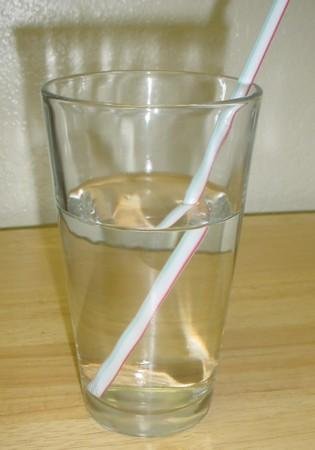The Effects of Water Density
As divers, we have to deal with the effects of water density. Water is about 800 times denser than air, and the first effect noticed by most people is the increased effort required to move while in the water. But this is just one effect of water density. Objects appear differently, sounds are more pronounced, and you get cold faster. In this lesson, you'll learn about the density of water and how it affects us as divers.

The Density of Water
The density of fresh water is 62.4 lbs/ft³, and the density of salt water is 64 lbs/ft³. Salt water is denser because of the dissolved salt.
Fortunately for us, water doesn't significantly compress when pressure is applied, so the density does not change with depth. This means that no matter how deep you dive, effects of density such as swimming resistance remain the same.

Water and Refraction of Light
As light passes from air to water, its speed slows down and the light rays are bent. This is called "refraction," and affects the appearance of everything you see underwater.
Refraction causes objects to appear 33% larger and closer. You can see this effect by placing a straw in a glass of water. The straw appears to break at the surface of the water because the portion in the water appears closer and larger than the portion above the water.
Divers must consider the effects of refraction when judging distances and the size of marine life. Objects that appear to be within reach are actually farther, and those fish that appear massive are actually much smaller.

Water and Absorption of Color
The density of water also affects colors. Water absorbs colors of the light spectrum as light rays travel through the water, and this is called absorption.
Red is the first color absorbed, followed by orange, yellow, green, blue, indigo, and violet. A useful way to remember this order is "ROY-G-BIV." Red and orange are absorbed at about 20 feet, while blue, indigo, and violet are absorbed far beyond maximum diving depths.
This is why underwater photos and videos seem washed out with blues. To see the full range of colors while underwater it's a good idea to carry a flashlight. This will bring out colors you never imagined existed.

Effects of Water Density on Sound
Sound travels 4 times faster in water than it does in air. This has dramatic effects on how you hear sounds underwater.
Sounds are more pronounced underwater. You'll hear bubbles from divers you can't even see. Tiny creatures make sounds you'll hear everywhere. And boats that are a great distance from you will sound like they're directly overhead.
When diving, it's impossible to judge the direction sounds are coming from. This is because the increased speed prevents us from hearing a delay from one ear to the other. Keep this in mind when you hear a boat overhead. Since it's impossible to tell if it's traveling towards you or away from you, don't surface while you hear a boat overhead.
Effects of Water Density on Body Heat
Whenever two substances are in contact, heat is transferred from the warmer substance to the cooler substance. This is called conduction, and is the reason we get hot or cold depending on weather conditions.
Because water is denser than air, heat is conducted from our skin about 25 times faster in water. This is why 55°F air is comfortable, but water of the same temperature can be bone chilling.
Conduction of heat continues until the temperatures of both substances equalize. Unfortunately, we experience hypothermia when our body temperature drops just a couple degrees. Shivering is a warning sign that your body temperature is dropping, so abort your dive immediately if you start shivering.

Effects of Water Density on Drag
Drag is any resistance to movement. We encounter drag when we move on land because we constantly displace air. But air isn't very dense, and its drag is rarely noticeable.
Drag is increased in the water because of the increased density. To minimize drag and make swimming easier, it's important to streamline yourself. This decreases the effort required to move in the water and makes your fin kicks more efficient.
The most important step to take in streamlining yourself is positioning your body in a horizontal position. This decreases the amount of water that is displaced as you swim. To further streamline yourself, secure all hoses and equipment close to your body.

